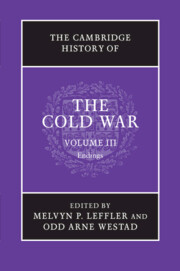Book contents
- Frontmatter
- 1 The Cold War and the intellectual history of the late twentieth century
- 2 The world economy and the Cold War, 1970–1990
- 3 The rise and fall of Eurocommunism
- 4 The Cold War and Jimmy Carter
- 5 Soviet foreign policy from détente to Gorbachev, 1975–1985
- 6 Islamism, the Iranian revolution, and the Soviet invasion of Afghanistan
- 7 The collapse of superpower détente, 1975–1980
- 8 Japan and the Cold War, 1960–1991
- 9 China and the Cold War after Mao
- 10 The Cold War in Central America, 1975–1991
- 11 The Cold War and southern Africa, 1976–1990
- 12 The Gorbachev revolution and the end of the Cold War
- 13 US foreign policy under Reagan and Bush
- 14 Western Europe and the end of the Cold War, 1979–1989
- 15 The East European revolutions of 1989
- 16 The unification of Germany, 1985–1991
- 17 The collapse of the Soviet Union, 1990–1991
- 18 Science, technology, and the Cold War
- 19 Transnational organizations and the Cold War
- 20 The biosphere and the Cold War
- 21 The Cold War and human rights
- 22 The Cold War in the longue durée: global migration, public health, and population control
- 23 Consumer capitalism and the end of the Cold War
- 24 An ‘incredibly swift transition’: reflections on the end of the Cold War
- 25 The restructuring of the international system after the Cold War
- Bibliographical essay
- Index
- References
16 - The unification of Germany, 1985–1991
Published online by Cambridge University Press: 28 September 2010
- Frontmatter
- 1 The Cold War and the intellectual history of the late twentieth century
- 2 The world economy and the Cold War, 1970–1990
- 3 The rise and fall of Eurocommunism
- 4 The Cold War and Jimmy Carter
- 5 Soviet foreign policy from détente to Gorbachev, 1975–1985
- 6 Islamism, the Iranian revolution, and the Soviet invasion of Afghanistan
- 7 The collapse of superpower détente, 1975–1980
- 8 Japan and the Cold War, 1960–1991
- 9 China and the Cold War after Mao
- 10 The Cold War in Central America, 1975–1991
- 11 The Cold War and southern Africa, 1976–1990
- 12 The Gorbachev revolution and the end of the Cold War
- 13 US foreign policy under Reagan and Bush
- 14 Western Europe and the end of the Cold War, 1979–1989
- 15 The East European revolutions of 1989
- 16 The unification of Germany, 1985–1991
- 17 The collapse of the Soviet Union, 1990–1991
- 18 Science, technology, and the Cold War
- 19 Transnational organizations and the Cold War
- 20 The biosphere and the Cold War
- 21 The Cold War and human rights
- 22 The Cold War in the longue durée: global migration, public health, and population control
- 23 Consumer capitalism and the end of the Cold War
- 24 An ‘incredibly swift transition’: reflections on the end of the Cold War
- 25 The restructuring of the international system after the Cold War
- Bibliographical essay
- Index
- References
Summary
The Cold War and the division of Germany were closely related; at the core of both was the question of which power was to dominate the center of Europe: the Soviet Union or the United States. The Berlin Wall was its starkest symbol. Lurking in the background was the political and military presence of the four victorious powers of World War II in Berlin and Germany. No element of this structure could be overcome without changes in the others. The East–West conflict would only be ended if the Wall came down and Germany were reunified.
Given these strong linkages, two questions arise: how was it possible that in 1989 the Wall that for twenty-eight years had separated the Federal Republic of Germany (FRG) from the German Democratic Republic (GDR) crumbled visibly, and that unification took place with the consent of all four powers who also withdrew most of their troops from Europe?
The consolidation of the status quo
After the Helsinki Conference of 1975, the two superpowers as well as the two German states felt comfortable respecting the modus vivendi on the territorial status quo in Europe, which had been achieved through détente and German Ostpolitik. When contacts grew after the conclusion of the Basic Treaty between the FRG and the GDR, East Berlin intensified its policy of demarcation: to emphasize its disparity with capitalist West Germany, the GDR defined itself as a “socialist workers’ and peasants’ state” whose alliance with the USSR was “irrevocable.”
- Type
- Chapter
- Information
- The Cambridge History of the Cold War , pp. 333 - 355Publisher: Cambridge University PressPrint publication year: 2010
References
- 1
- Cited by

